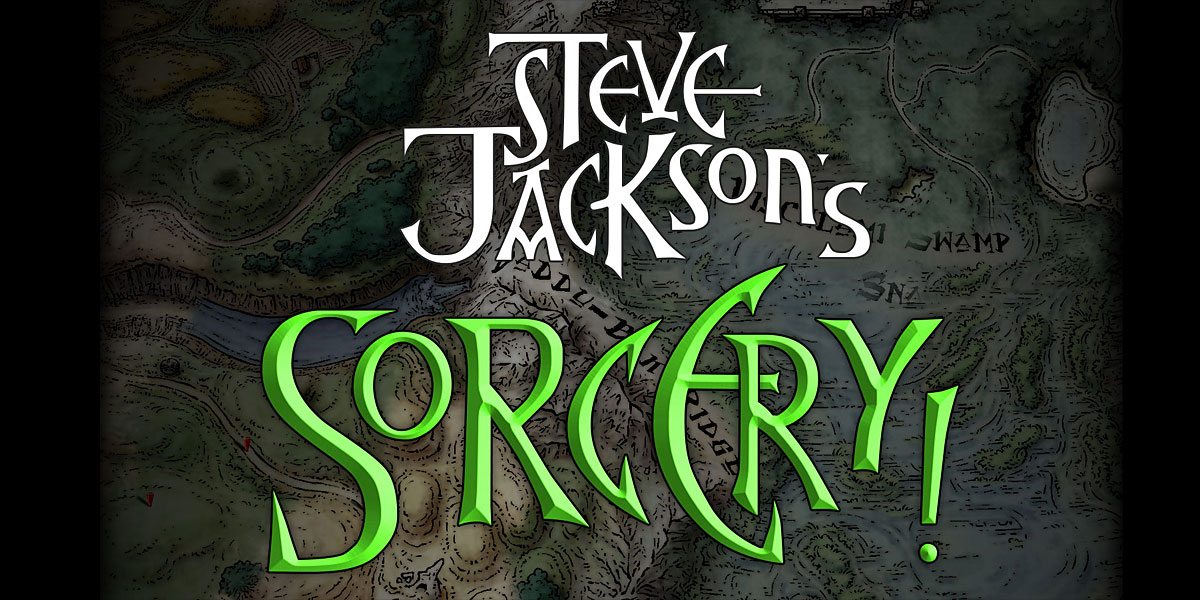1979’s Alien by Ridley Scott is the classic horror sci-fi film that is surprisingly good even over 40 years later. It, of course, also launched a hit-and-miss franchise that continues to this day. And while there have been board games based on the franchise before, few have done as good a job at capturing the feel and story of the original movie as Alien: Fate of the Nostromo.
What Is Alien: Fate of the Nostromo?
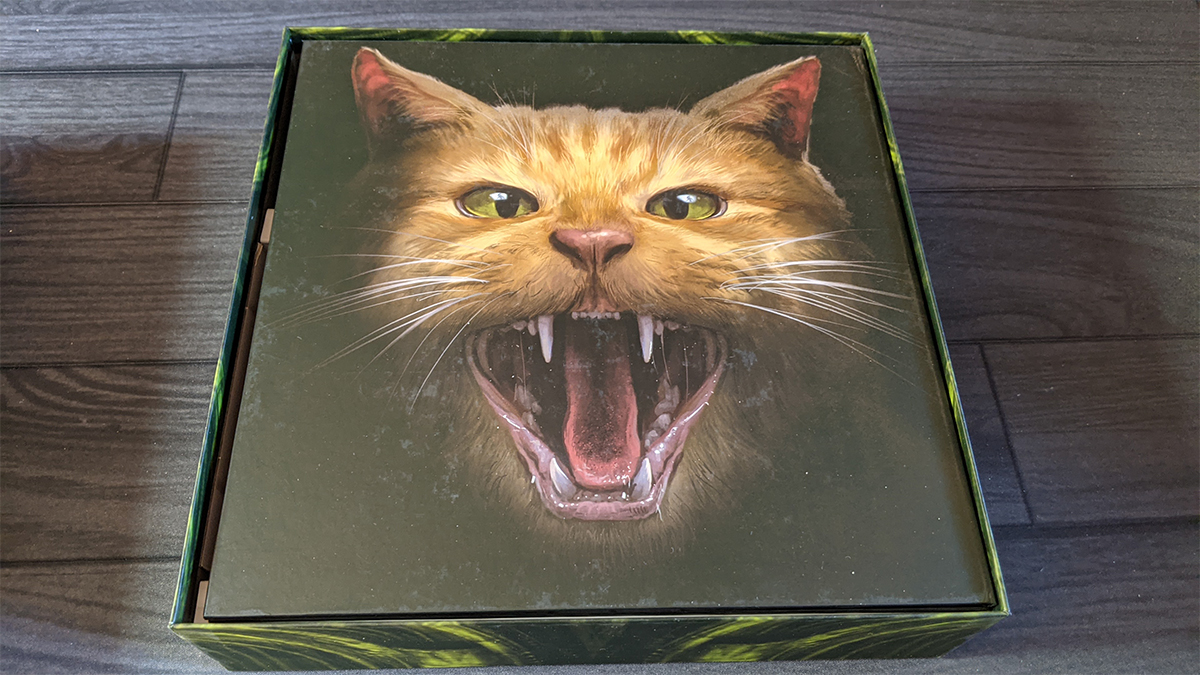
Alien: Fate of the Nostromo is a cooperative game for 1-5 players, ages 10 and up, and takes about 45 minutes to play. It’s currently available at Target.
Alien: Fate of the Nostromo was designed by Scott Rogers and published by Ravensburger.
Alien: Fate of the Nostromo Components

Inside the box, you’ll find:
- 1 game board representing the USCSS Nostromo
- 5 player reference cards
- 5 crew placards
- 5 crew figures
- 1 Alien figure
- 1 morale marker Alien standee
- 1 Ash standee
- 2 standee bases
- 21 encounter cards
- 10 objective cards
- 5 final mission cards
- 20 scrap tokens
- 12 item tokens
- 6 coolant canisters
- 13 concealed tokens
- 1 self-destruct track
- 4 countdown tokens
The components are all of the highest quality, as you’d expect from a Ravensburger game.

The board shows a stylised map of the layout of the Nostromo, with the key rooms from the movie and corridors attaching them. It’s always a bit of a challenge to translate a complex space into a board game, made all the more difficult by the fact that the layout of the ship isn’t ever really made clear in the movie. But neither of those points really matter here: even for fans of the film like myself the map works well. There are two basic levels of the ship, connected with ladders in two of the rooms, which further limits movement around the ship. (Missing from the game are the ducts that famously figure into one particularly tense sequence in the movie, but that’s an OK omission as well.)

Games too often leave out easy reference cards, forcing players to dig through the rulebook to find out their action options or costs of things or the like. Thankfully, this game didn’t forget those. The reference cards are two-sided.

During the game, players take on the role of one of the (surviving, human) crew members. These are represented by plastic figures and crew placards. I have to say that the details on these figures is excellent.

The crew placards, printed on nice heavy cardboard, show the number of available actions for each character and provide spaces for the character to hold items they collect. These are color-coded to the figures.

Of course, the movie is nothing more than a deep-space union promotion video without the titular alien, and here the game doesn’t disappoint. While the crew figures have nice details, this one is even better. There’s more than a little temptation to leave this out of the box and just have it on a shelf.

The other representation of the alien is the morale marker, a cardboard piece that fits into a plastic stand. They could have chosen just about any other image to use to represent crew morale, but deciding to use the alien was a nice choice.

Throughout the game, players draw encounter cards, which are the primary thing that moves the game forward. The deck includes 21 cards. Just over half—11 of the cards—are “quiet” cards that only move the alien and place items on the board. Then there are six “alien” cards that move the alien without placing items, although one (shown at the end of the third row in the image above) also reshuffles the deck. Finally, there are four “order 937” cards that simulate the company, through the MU-TH-UR computer, working against the crew.

The players’ goal in the game is to first complete two objectives, then a final mission. The objectives are from two cards drawn from the ten-card deck at the beginning of the game. The other cards will not be used, but the deck ensures some variability from one game to the next.
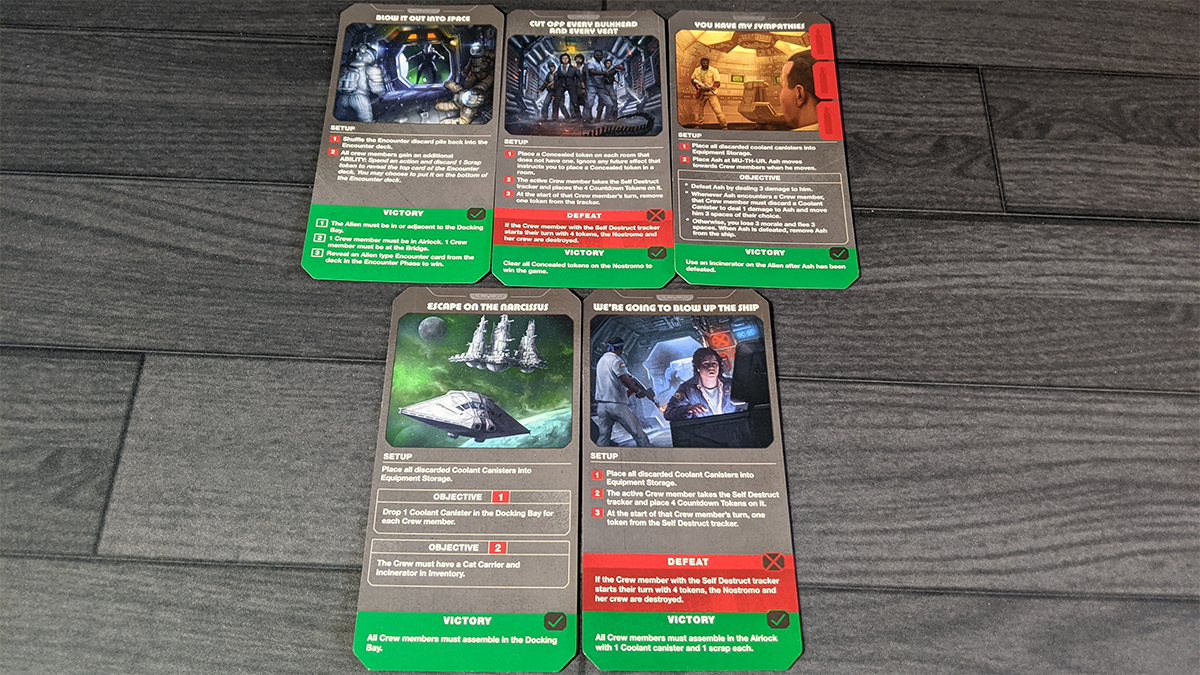
Each game also begins with drawing one of the five final mission cards, which must be completed after the objectives to win.

Throughout the game, players will collect scrap from throughout the ship and use it to create items to fight the alien and complete objectives. The scrap is represented by 20 heavy cardboard tokens. The items, which include an incinerator, grapple gun, motion tracker, flashlight, cat carrier, and electric prod, and the coolant canisters, are all also represented by heavy cardboard tokens.

As you move about the ship, you can’t be sure what you might find from one room to the next, and this element of jump scare is represented in the game by concealed tokens, which are, again, printed on heavy cardboard. Eight of the thirteen tokens are “safe,” where nothing happens. Three of them represent finding the alien, which triggers a host of bad things, and two of them have you stumble across Jonesy, again resulting in negative effects.

Two of the final missions have the players race against time to escape the ship before it self-destructs. This sequence is represented by the self-destruct track and countdown tokens. Printed on the same heavy cardboard as most of the other components, the track shows the Nostromo‘s cool (if somewhat non-sensical) self-destruct panel, while the tokens represent those four-pillar things that move down as the countdown proceeds.
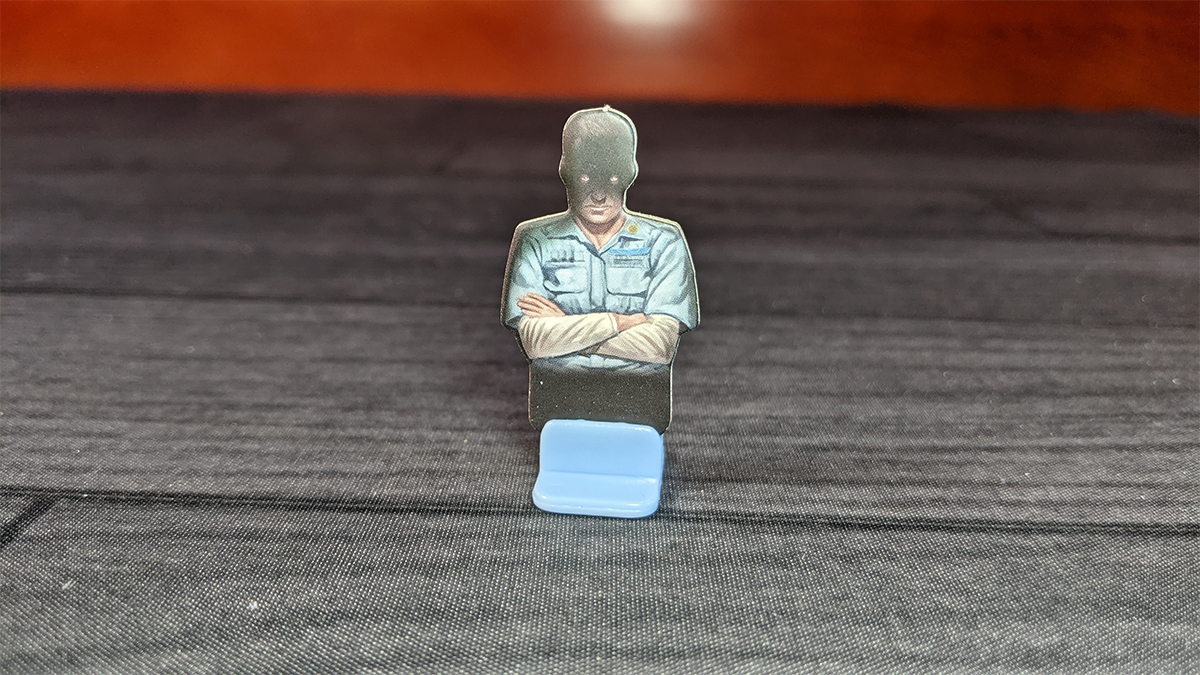
Finally, we have Ash. Designer Scott Rogers has said on Boardgame Geek that the specification for designing the game was a “cooperative game with no player elimination and no traitor mechanic,” so including Ash as a character was out of the question. (That’s also why everyone either survives or dies in the game, unlike the “picking them off one-by-one” that happens in the movie.) Rather than leave out the all-important synthetic person, though, the game includes him and a set of rules for him as an alternative, more challenging game. Ash is represented by a cardboard standee, similar to the alien on the morale tracker.
How to Play Alien: Fate of the Nostromo
You can download a copy of the rulebook here. Note that the PDF contains a slightly updated version of the rules from the one included with the game.
The Goal
The goal of the game is to complete two goals and a final mission before the morale track reaches zero, or, in the case of two of the missions, before the ship blows up.
Setup

To set up the game, start by placing the board on the table. The rules suggest that you familiarize yourself with the map. Then, place the morale marker on space 20 if playing with 4 or 5 players, or 15 if playing with 1, 2 or 3. Two scrap tokens are placed on each of the following locations: Garage, MU-TH-UR, Med Bay, and Maintenance. (Note that this and several of the following steps contain a typo in the printed rules, in that they refer to “Maintenance Bay,” which the map has labeled as merely “Maintenance.” For clarity, I’m correcting it to match the map, and the PDF does not have these mistakes, or the others noted below.)
Next, the concealed tokens are shuffled. One each is placed in the Garage, Workshop, and Maintenance. The rest are placed in a face-down stack next to the board. A coolant canister is placed in the Workshop, Garage, Maintenance, Equipment Storage, MU-TH-UR, and Hyper Sleep. The equipment tokens should be placed next to the board. Then, the objective cards are shuffled. Two are drawn and placed face-up above the board, and the rest are returned to the box. Shuffle the final mission cards, place one face-down next to the objectives, and return the others to the box. (Note that if playing solo with only one character, you need to remove the “Cut Off Every Bulkhead and Every Vent” and “Blow It Out into Space” final missions before shuffling.)
The encounter cards are then shuffled and placed next to the board. Here again is another typo in the printed book: it says to place the deck “on the space indicated on the game board,” but no such space exists. In fact, the space isn’t even there on the image of the board in the rules. Again, the PDF corrects this.
Players choose a character (or characters)—like all cooperative games, players can choose to play multiple characters if they choose, including always using all five. Strangely, at no point does the rulebook mention this, or provide any real guidance as to which characters go well with each other, which combinations might be harder to play, or the like. Players take the placard for their chosen character and a reference card.
The alien is placed in the Nest, and all player figures start in the Galley. If playing with Ash, he is placed in the Med Bay.
The rules say that the player who most recently had a cat hiss at them goes first, but of course any method of choosing the start playing works.
Gameplay
On each turn, the active player performs a crew action phase and an encounter phase.
Each crew member has a set number of actions they can perform: Dallas has 5, Brett 3, and the others 4 each. Actions available including moving, picking up and dropping off items, using items, performing special actions, crafting items, and trading. Any action can be performed multiple times, and actions can be performed in any order.
Moving is straight-forward: each space on the board counts as one action. Players can freely move about the ship, using the ladders to move between decks. The only limitation on moving, other than the number of actions and obviously not moving through walls, is that certain concealed tokens may cause you to have to stop, and you have to stop if you encounter the alien or Ash. There’s no limit to the number of characters who can be on one space at a time.

When moving into a room, a player can pick up any number of scrap tokens in that room and place them near (or on) their player placard. They may also pick up a single item in the room. All characters can carry one coolant canister and up to three additional items and any number of scrap tokens. Players can also drop any item they are carrying. Note that picking up or dropping an item requires an action for each item, but you can pick up as much scrap as you want for a single action.
Once acquired, you can use an item for an action. The flashlight, cat carrier, and electric prod can be used any number of times, while the incinerator, grapple gun, and motion tracker have a limited number of uses before they must be discarded. Coolant canisters are important for some of the objectives and missions and for crafting items and generally have to be discarded on use.
Some characters have a special action that can be performed on their turn. For example, Ripley can spend an action to move any other character. Unless noted on the placard, special actions can be performed more than once, just like regular actions.
When the game begins, none of the items except coolant canisters are on the board. In order to get these items, players have to craft them. They do this by discarding scrap tokens: 1 for the cat carrier, 2 for the flashlight, 3 for the grapple gun or electric prod, and 4 for the incinerator. The printed rules list the cost of the motion tracker at 3, while the PDF has it at 2. Crafting items can be done by any character (although Brett’s ability reduces the cost to do so) in any room.
Finally, any character can trade any number of scrap tokens or items with other characters in the same room for an action.
After completing their crew action phase, the active player completes an encounter phase by simply turning over the top card of the encounter deck and doing what the card says. Most of the cards are “Quiet” cards, which cause the alien to move—it will always move towards the closest crew member—and then add additional scrap and concealed tokens to the room designated on the card. The deck also contains a set of “Alien” cards that simply move the alien, and a set of “Order 937” cards that have special instructions on them.
Alien Encounters
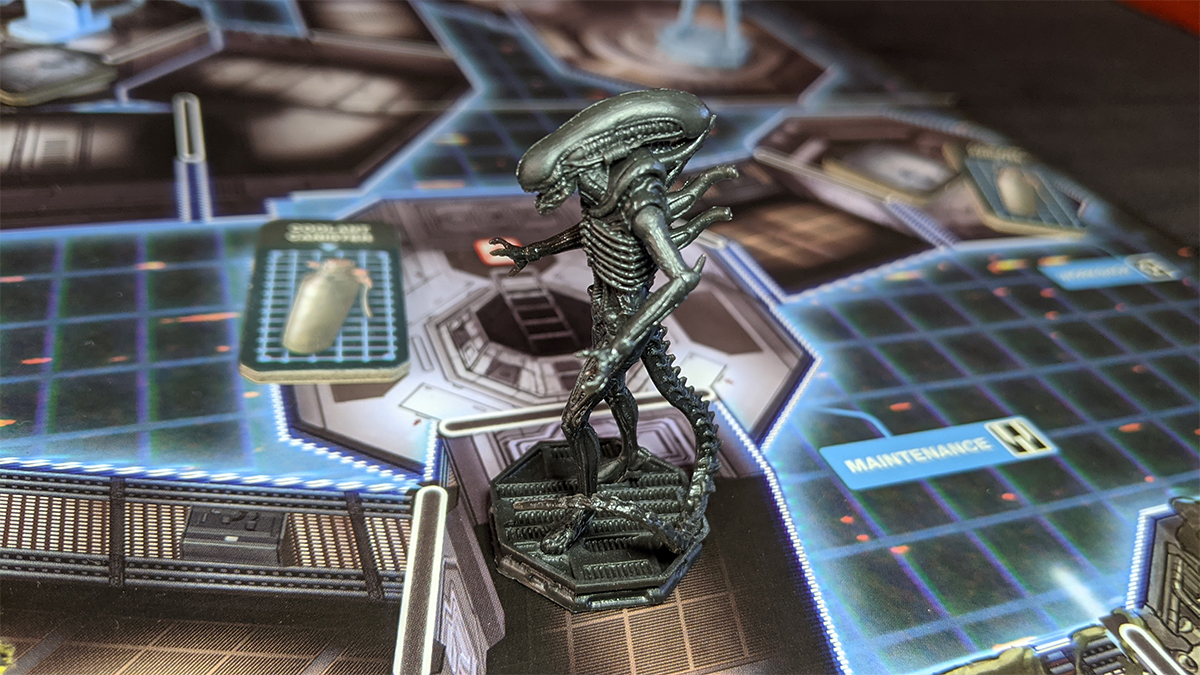
As the crew move around on the ship, they will turn over concealed tokens whenever they enter a room with one. If the counter has the alien symbol on it, the alien immediately moves to that room. The crew lose morale equal to the number printed on the token, and then each crew member must flee three spaces in any direction. (Note that it might be possible to move down a dead-end corridor and thus flee fewer than three spaces, but except in that case, you have to move three spaces.) If, in fleeing, the crew member moves into another room with a concealed token, they flip it over, and if it is the alien again, they again lose morale and have to flee. While not specifically stated in the rules, if there were multiple crew in the original room, and the first one moving out reveals a concealed token that moves the alien, the other crew in the first room no longer have to flee since the threat is gone.
The alien might also be encountered by its own movement in the encounter phase. All of the same rules apply if the alien moves into a room with crew: morale equal to the amount on the card is lost, and crew must flee.
The morale loss may be reduced by one if any crew member in the room has the flashlight.
Jonesy
Two of the concealed tokens have Jonesy on them. When these are encountered, crew lose one morale. However, if the crew member that reveals Jonesy has the cat carrier, they can capture the cat instead of losing morale.
Ash Variant
A more challenging game involves the use of the Ash standee. Ash starts in the Med Bay. When required to do so by one of the “Order 937” cards, Ash will move. Like the alien, he will always move towards the nearest crew member. Anytime he moves into a room with scrap, he discards all of those tokens. If he encounters a crew member, he stops. Each crew member in that space must discard one scrap or lose one morale. However, if a crew member stays in the room with Ash, he will stop moving.
Game End
The game ends when both of objectives are complete and players also complete the final objective, in which case they win. However, if their morale track drops to zero, they lose. Players also lose if they fail to complete either of the final missions that involve the self-destruct track in time.
Why You Should Play Alien: Fate of the Nostromo
While I remember vividly the first time I saw Aliens, I don’t actually know when I first saw Alien (other than sometime after Aliens.) I also can’t begin to count the number of times I’ve watched it since. (In fact, I even watched it while writing this review.) It truly is a masterpiece of both science fiction and horror.
I was therefore pretty excited when I was going to be given the chance to look at this new board game based on the movie. I was even more excited when I learned that it was designed by Scott Rogers, a game designer I very much like and respect.
The game itself, I think, lived up to the expectations. It’s got a lot of strategy, and yet is simple enough to be able to be taught fairly quickly and plays in under an hour. Like most cooperative games, and basically all co-op games with no hidden information, it plays just as well solo as it does with multiple players.
The kind of true horror one finds in the movie is tough to duplicate in a game, but Rogers did fairly well capturing the tension of the film (although I’ll still admit to wishing he’d found some way to integrate the duct scene).
But for everything the game gets right, the extremely subpar rule book brings it down. It’s frustratingly not uncommon these days to have to go to BGG to get clarification on some finer points in rulesets, so I don’t necessarily hold it against anyone involved in this game that things like the ability to “flee” for fewer than three spaces on a dead-end isn’t in the book. But there are some pretty big key elements that are just missing. Take, for instance, the issue of playing with less than five players. Almost every other cooperative game I can think of spells out exactly what should be done in this case: do you play with all five characters anyway or reduce it down, even playing the solo game with a single character? That latter case is implied in the setup, but I would definitely have expected to see that explicitly stated.
And then, there are the frankly inexcusable typos. How did a major game publisher go to print on such a huge license like this and not catch that the setup instructions reference something that isn’t on the board or that it gets the name of a room and the cost of an item wrong? It truly boggles the mind.
Rogers, for his part, has so far been very active on the BGG forums helping to clear up some of these issues. He has also posted an additional set of rules that make the game even more challenging. Is calling these his “Director’s Cut” perhaps just his sense of humor, or is it possibly a subtle statement that some decisions were out of his control? We don’t know, but if you are interested in playing with those rules, you can read them here.
In the end, I think that fans of the franchise will want to have this game on their shelves and will likely enjoy playing it for the nostalgia. I mean, I’d almost have been tempted to buy it just for the alien figure. But board game fans will likely find the problems with the rulebook frustrating enough that they might look elsewhere for their cooperative horror gaming fix. That’s unfortunate, as they’d be missing out on a good game, but at the same time, somewhat understandable. It is too bad that the rulebook was so rushed that it brings down an otherwise fun game. At least more serious gamers can grab the corrected rules online, and maybe there will someday be a second printing with a good book. Time will tell.
Click here to see all our tabletop game reviews.
![]() To subscribe to GeekDad’s tabletop gaming coverage, please copy this link and add it to your RSS reader.
To subscribe to GeekDad’s tabletop gaming coverage, please copy this link and add it to your RSS reader.
Disclosure: GeekDad received a copy of this game for review purposes.



